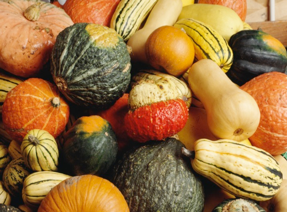Winter Squash-as Beautiful as It Is Nutritious
go.ncsu.edu/readext?557872
en Español / em Português
El inglés es el idioma de control de esta página. En la medida en que haya algún conflicto entre la traducción al inglés y la traducción, el inglés prevalece.
Al hacer clic en el enlace de traducción se activa un servicio de traducción gratuito para convertir la página al español. Al igual que con cualquier traducción por Internet, la conversión no es sensible al contexto y puede que no traduzca el texto en su significado original. NC State Extension no garantiza la exactitud del texto traducido. Por favor, tenga en cuenta que algunas aplicaciones y/o servicios pueden no funcionar como se espera cuando se traducen.
Português
Inglês é o idioma de controle desta página. Na medida que haja algum conflito entre o texto original em Inglês e a tradução, o Inglês prevalece.
Ao clicar no link de tradução, um serviço gratuito de tradução será ativado para converter a página para o Português. Como em qualquer tradução pela internet, a conversão não é sensivel ao contexto e pode não ocorrer a tradução para o significado orginal. O serviço de Extensão da Carolina do Norte (NC State Extension) não garante a exatidão do texto traduzido. Por favor, observe que algumas funções ou serviços podem não funcionar como esperado após a tradução.
English
English is the controlling language of this page. To the extent there is any conflict between the English text and the translation, English controls.
Clicking on the translation link activates a free translation service to convert the page to Spanish. As with any Internet translation, the conversion is not context-sensitive and may not translate the text to its original meaning. NC State Extension does not guarantee the accuracy of the translated text. Please note that some applications and/or services may not function as expected when translated.
Collapse ▲As the weather changes people often look to decorate their homes with pumpkins and squash. While they make beautiful decorations many are also great to eat. Squash varieties harvested in fall are known as winter squash. Winter squash have richer, darker colors than summer squash varieties and far surpass them in nutritional benefits.
Popular winter squash varieties include but are not limited to: acorn, buttercup, butternut, pumpkin, and spaghetti. Each type is different in color, shape, size, and flavor but all have tough outer shells. While the hard shell can make cutting and peeling more challenging, it provides the squash with a longer shelf life.
The nutritional quality of each winter squash varies but all have common health benefits. Winter squash is full of complex carbohydrates and fiber. Although many diets shy away from carbohydrates, they are actually one of the 7 essential nutrients our bodies need. Carbohydrates fuel our bodies, giving us energy and helping our brain to function properly. Fiber plays a key role in our body’s digestive system.
Potassium, niacin, iron, and beta-carotene are also nutrients found in winter squash. In the body, beta-carotene becomes Vitamin A, essential for healthy skin, vision, bone development and, many more body functions. Generally, the darker the orange color, the higher the beta-carotene or Vitamin A.
When selecting squash look for ones with hard shells, no soft spots and a heavyweight for size. Soft spots indicate the squash was picked too early, and a lightweight indicates that the inside of the squash has begun to dry. If properly stored, winter squash can last up to 3 months in a cool, dry space.
The options are endless for delicious winter squash recipes. Acorn squash can be prepared in the oven or microwave. After cooking it can be scooped out to add to recipes or stuffed with a mixture of your choice.
Roasted Acorn Squash
Preheat oven to 400ºF degrees and line a large baking sheet with parchment paper. Cut acorn squash in half and scoop out the seeds. Drizzle with olive oil, sprinkle with salt and pepper and place on baking sheet cut-side down for 40-50 minutes. Squash is done when the cut-side is slightly caramelized and the middle is tender.
Microwave Acorn Squash
Cut acorn squash in half. Remove and discard seeds and fiber. In a shallow microwave-safe dish, place squash cut-side down. Put 1 tbsp of water in the bottom of the dish. Microwave covered on high for 10-12 minutes or until tender.





